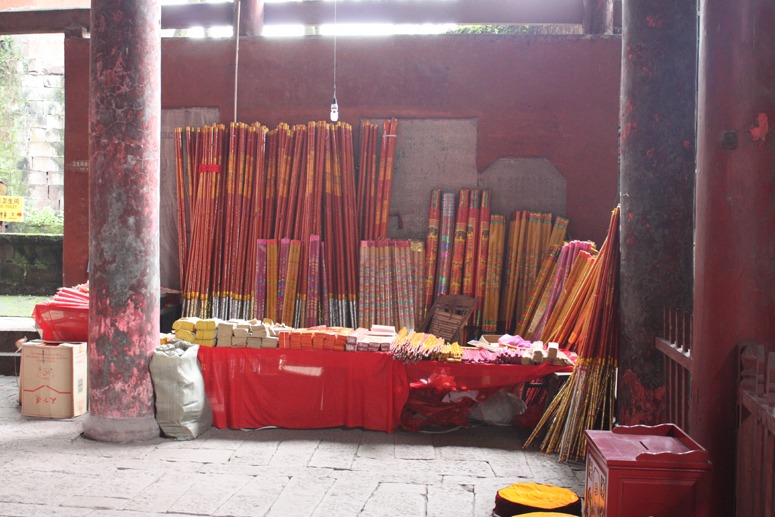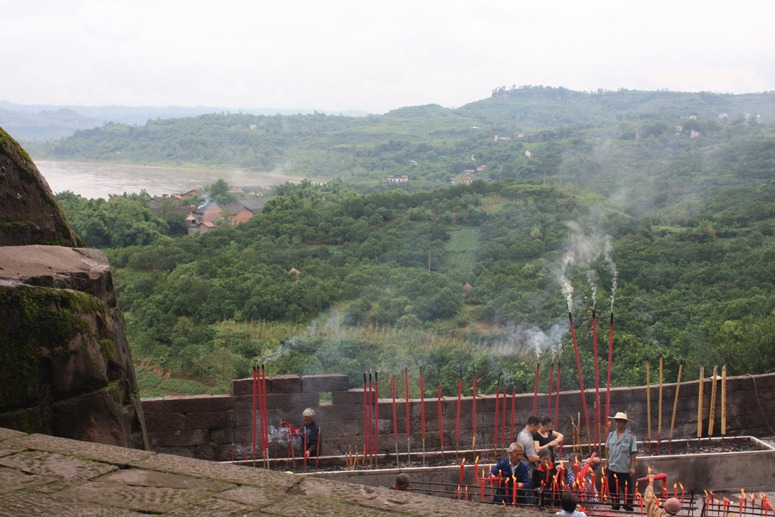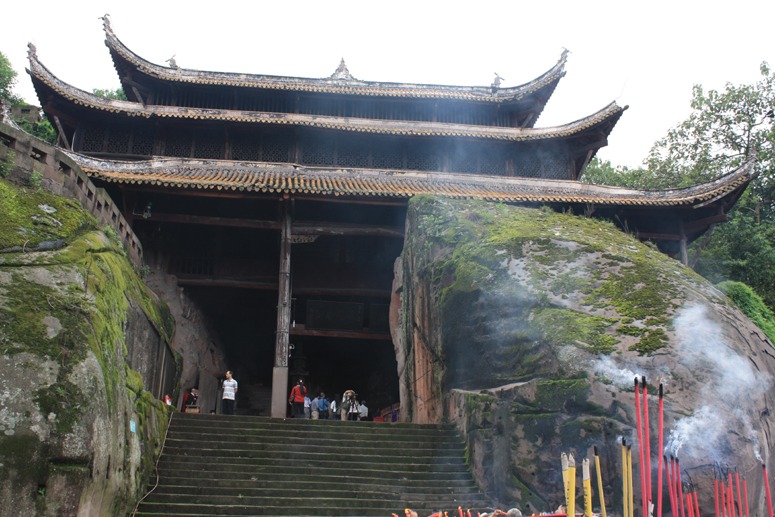


 I often light candles for people I know in European churches and cathedrals. I don’t really know why I do this because I am not a Believer. I am also fascinated by the use of incense in Asia. I like the habit even more now that I have just read this:
I often light candles for people I know in European churches and cathedrals. I don’t really know why I do this because I am not a Believer. I am also fascinated by the use of incense in Asia. I like the habit even more now that I have just read this:
The practice of offering incense, with a bow, to the Taoist altar is called Baibai. As the incense burns, smoke rises, and ashes fall. The ashes represent impure air that sinks; the smoke, pure air that rises. So the offering represents the separation of pure from impure – the refinement and purification of internal energies. It also symbolizes the human body as being the meeting-place of Heaven and Earth: as the smoke rises, and the ashes fall, we make a connection with both earth and sky.
This temple is in the countryside around Chongqing and houses a rock Buddha some 9 meters tall, the building makes its own connection between the earth and the sky. The title quote is from the Vijnanabhairava Tantra.

What enormous insense sticks! I wonder about the history of incense. Wiki traces it to Sumer and suggests it reached the Far East via Japan. http://en.wikipedia.org/wiki/Incense Perhaps it comes from an older tradition of sacrifice.
The temple roof floating above the great boulders is an inspiring example of ‘landscape architecture’
Tom glad to see both you and I are inspired by the temple as ‘landscape architecture’. Taoist temples are of three types, palace like temples, ordinary temples or simple huts or caves. Taoist temples will be guarded by a Dragon (yin) and Tiger (yang). Buddhist temples, while similar in architecture, will be guarded by Giants. [ http://en.wikipedia.org/wiki/File:Plaosan_Temple_Guardian.jpg ]
The incense is burnt to purify and refine the three treasures, Jing (essence), Qi (vitality) and Shen (spirit). The incense burner represents the lower abdominal area where this transformation takes place. This practice is associated with qigong.
The path of transmutation transforms essence into vitality into spirit, while the path of generation or manifestation reverses the process and transforms spirit into vitality into essence.
My, slight, problem with incense is a doubt about it being part of the essense of either Buddhism or Daoism. But setting this aside, do you think there is potential for the introduction of incense burning as an aspect of contemporary urban and landscape design? The large incense sticks in Lawrence’s photographs set me thinking about new urban processional paths lined with incense sticks. It could become part of the modern Olympic Games. Smoke was part of the experience of visiting the oracle at Delphi. The 2012 Olympic Park in London will have a linear Olympic Garden which is an 800m path lined with Art Nouveau wild flower meadows. It could also have a PROCESSION with lines of incense sticks and lights flickering into the smoke. Seats for the opening ceremony will cost up to £2000. This could be a free procession for a very large number of Londoners and it would provide the world with some spectacular photographic opportunities.
After the 2012 Games the route could be used for demonstrations. The strength of public opinion on various issues could be gauged by the number of processors and the number of incense sticks they purchased. I like demos and each participant could ‘See the entire world as a blazing inferno. Then, when all has turned to ashes, enter bliss’.
If Landscape architecture have a definition: Landscape + Architecture, so the bottom photography will be a very good model. Another similar one:Haning Temple (http://en.wikipedia.org/wiki/Hanging_Temple)
I am acturally confused with the function of incense in Buddhism and Taoism. But insence in China is a culture and has a long history(http://en.wikipedia.org/wiki/Incense_in_China). The first three pictures are really “scared” in my view, which are not like a activity of insence but like a preparation for ‘WAR’ or a preparation for a big BBQ. If we burning insence like this, probabaly, all the Taoist spirit of insence will be totally, totally and totally destroyed.
I don’t know whether the giant incense sticks are a symptom of a modern “more is better” philosophy making headway within China, or whether they have a long history of use at this site and elsewhere. In view of the size of the central Buddha and the epic landscape panorama commanded by the temple I found the scale of the sticks very appropriate. Hopefully this won’t catch on at the Tianhou Palace, Tian Yuan! Do you think that China is becoming hopelessly materialist, as some commentators are suggesting?
I think that flaming torches would be the better choice for the London Olympics processional routes. Incense is dreamy, flames are enervating. But there could be an armful of giant sticks burning permanently near to the Olympic Flame, that would be poetic. The French used to gauge the strength of public opinion by the amount of cobbles that were prised from the streets and flung through the surrounding windows by demonstrators.
Lawrence, I agree with you about the use of burning stick near to the Olympic Flame in London. It sounds much better than incense and torches. Because “fire” have a dynamic effect and charming color. However, I may not agree with you regarding to the scale of the giant which is appropriate. I think your idea is based on the concern of visual scale, but as a spiritual space
(Temple) will have another ‘scale’ which could be defined as ‘Spiritual scale’. It is a little bit like we still use a very small cup for drinking coffee even although we may live in a very large room. Because we know that if we find a giant cup to suit for the panorama scale, the cup may change to fish tank.
About China’s recent situation: well, I would like to say it is very materialist now, but it would happen in any country if they had experienced a similar/same development process as China. Materialist may be very good for economy, but not at all be good for education. Materialist changes most of the landscape tutors and supervisors to ‘bosses’ for students.
Fortunately the economy of Hong Kong, whose name as the fragrant harbour derives from the incense tree (aquilaria sinesis), no longer relies on the incense trade for its economic prosperity. See the very interesting paper on Joss Stick manufacturing in Hong Kong by Chan Ka Yan.
[ http://sunzi.lib.hku.hk/hkjo/view/44/4401661.pdf ]
More fascinating still was to see that New South Wales supplied the incense market with sandalwood once Hong Kong became part of the British Empire. After a time it seemed that sandalwood was grown locally in Hong Kong and the manufacture of joss sticks commenced.
Chinese bamboo is used in the manufacture of the longest joss sticks.
ps. Yuan, I think the Hanging temple dates to the introduction of Buddhism into China, rather than from the later period of religious harmonisation. Perhaps this explains the presence of the Taoist and Confucian references in this context. [ http://hubpages.com/hub/Xuan-Kong-Temple-Stuck-on-the-Cliffs ]
It is a fantastic building!
I like the visual idea of flaming torches but (1) the Health and Safety industry would never permit them (2) the symbolism of burning oil and polluting the air is unattractive (3) I think incense is more spiritual and flames are more material – so I agree with Yuan (4) I wish the Olympics were as much about mental culture as physical culture (as they were in Ancient Greece).
Re using thrown cobbles to ‘to gauge the strength of public opinion’ (wonderful understatement), the practice now seems to be working in the Arab countries, with dictatorial regimes topling and falling like dominoes. I would like to see Al-Jazeera, which has been doing a brilliant job, sending reporters to count the number of loose stones after each demonstration. The only problem with stones is that they cause injuries. My suggestion to the Iranians is to flutter protest notes out of their windows each morning and to drop them as they walk the streets. The winds of change blowing through the Islamic countries would then become visible and photographable and reportable.
Each time I see the words in the title of this blog post I like them better.
Tom, maybe, you can share some of thought about understanding the title if you like. What have you got when you see it?
Poetry cannot be converted to prose. But maybe I see life as ‘a blazing struggle’ and dream of ‘a long rest at the end of the day’.
The wikipedia entry for poetry is helpful here:
“Poetry (from the [Greek] ‘poiesis’/ποίησις [poieo/ποιεω], a making: a forming, creating, or the art of poetry, or a poem) is a form of literary art in which language is used for its aesthetic and evocative qualities in addition to, or in lieu of, its apparent meaning.”
I suppose this was the traditional distinction that used to be made between public life (the male sphere) and domestic life (there female sphere).
The public sphere was the place where males experienced a competitive struggle, while the domestic sphere was supposedly a place of comfort and refreshment.
[ http://www.library.csi.cuny.edu/dept/history/lavender/386/truewoman.html ]
Seen from this perspective Jane Jacobs’ [ http://www.drivers.com/article/894/ ] opposition to suburbia is more meaningful to gender politics [ http://www.notablebiographies.com/supp/Supplement-Fl-Ka/Jacobs-Jane.html ] than to the social reform or environmental movements. [ http://reason.org/news/show/122322.html ].
I understand and accept each of these polarities: poetry/prose, public/domestic, masculine/feminine, urban/suburban. but I have difficulty in equating them. Obviously, I need to do some more thinking.
Some great pictures here – we have written about this on our website in relation to Buddhism and incense and even put a video together – I hope you enjoy.
Kind regards
Ian
http://www.thebuddhasface.co.uk/fragrance-and-incenses-in-buddhism-72-c.asp
The video is at ;
http://www.youtube.com/watch?v=fIsDX-h2axs&feature=player_embedded